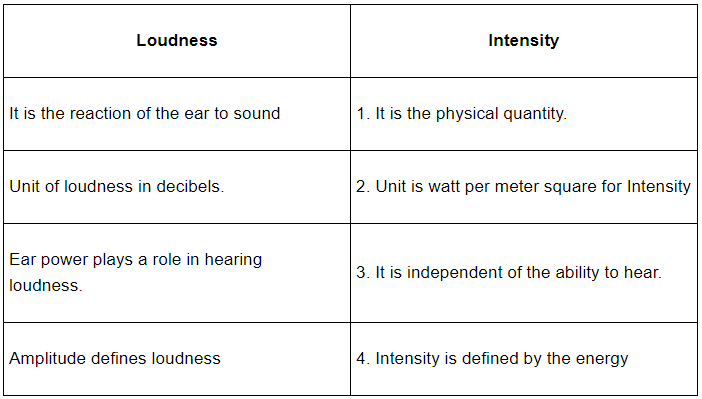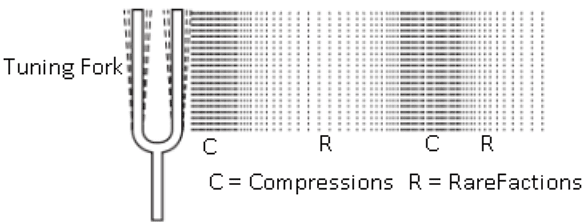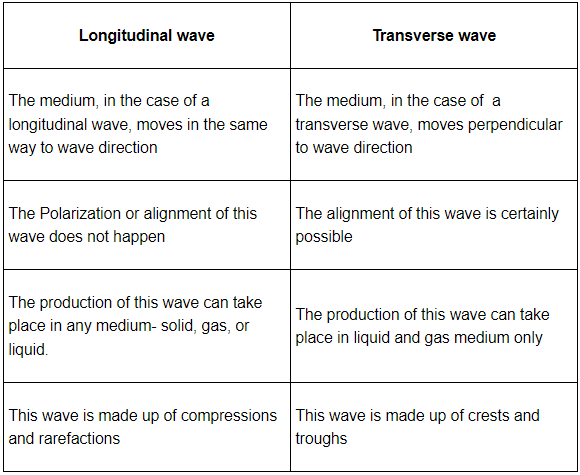Class 9 Science Chapter 11 Question Answers - Sound
Q1: Explain how sound is produced by your school bell.
Ans: The sound of the bell depends upon the vibration of the bell when it is rung. When the bell starts ringing, it drives the molecules around the air to vibrate. This produces the wave. So the compression is produced, however, the rarefaction makes the sound echo through the air.
Since, the vibrating molecules put pressure on one another, in turn, air particles are disturbed and start moving forward and backward.
Q2: Why are sound waves called mechanical waves?
Ans: Mechanical Waves are waves that generate through a medium (solid, liquid, or gas) at a wave speed. A sound wave is an example of a mechanical wave. Sound waves cannot travel through a vacuum, It requires some medium to propagate, which could be air, water, or metal similar to mechanical waves. That’s why; a sound wave is called a mechanical wave.
Q3: Suppose you and your friend are on the moon. Will you be able to hear any sound produced by your friend?
Ans: A sound wave needs a medium to propagate. Be it a solid, gas, or liquid medium. The moon resides in a vacuum; since it has no air that defines it has no medium to generate the sound waves. So, it is not feasible to hear any sound on the moon.
Q4: Which wave property determines
(a) Loudness,
Ans: The loudness of the sound is a decibel unit (dB). Loudness is defined as the intensity of the wave or the molecule. The determination of the loudness depends on the magnitude of the wave. Precisely, the amplitude of the wave determines the loudness of sound.
(b) Pitch
Ans: Pitch is defined as the response of the sound by ear which goes hand in hand. Higher the pitch, the higher the frequency. So, the pitch of the sound is dependent on the frequency of the sound.
Q5: How are the wavelength and frequency of a sound wave related to its speed?
Ans: Longer the wavelength, the longer will be the frequency waves. In the context of speed, it is dependent upon the medium through which the sound wave is traveling. The more inflexible, inelastic the medium, the faster will the movement of sound.
The equation forms as VW = fλ, where VW is the speed of sound, f is its frequency, and λ is its wavelength.
Q6: Calculate the wavelength of a sound wave whose frequency is 220 Hz and speed is 440 m/s in a given medium.
Ans: The wave with the greatest frequency has the shortest wavelength.
We have to calculate the wavelength of the sound with the frequency of 220 Hz and the speed will be 440m/s. Given: v=440 m/s , f = 220Hz
Given: v=440 m/s , f = 220Hz
The wavelength is
Q7: A person is listening to a tone of 500 Hz sitting at a distance of 450 m from the source of the sound. What is the time interval between successive compressions from the source?
Ans: The time interval between successive compressions from the source
T = 1/v = 1/500 = 0.002 second.
Q8: Distinguish between loudness and intensity of sound.
Ans: Differences between loudness and intensity of sound are:

Q9: An echo returned in 3 s. What is the distance of the reflecting surface from the source, given that the speed of sound is 342 m/s?
Ans:
Speed of sound = distance/time
Therefore, distance travelled by sound during echo = speed × time = 342 × 3 = 1026 m
so the distance of reflecting surface = 1026/2 = 513 m
Q10: Why are the ceilings of concert halls curved?
Ans: The curved architecture of any structure helps the sound to reach every end. Concert halls are very big, so the sound might not reach every corner of the hall. This is achieved when the sound generates the reflection technique to reach every corner.
Q11: What is the range of frequencies associated with
(a) Infrasound?
Ans: Infrasound is used for the sound below 20 Hz. Sound at 20-200 Hz is called low-frequency sound. The range of frequency is less than 20 Hz.
(b) Ultrasound?
Ans: Ultrasound adds biologically significant sounds ranging from 15 kHz or so up to 200 kHz, which is too high in frequency. So the range for Ultrasound = greater than 20 KHz
Q12: A submarine emits a sonar pulse, which returns from an underwater cliff in 1.02 s. If the speed of sound in saltwater is1531 m/s, how far away is the cliff?
Ans: Distance travelled by a sonar pulse = speed of sound in saltwater × time = 1531×1.02 = 1561.62 m
Therefore, the distance of cliff from submarine =1561.62/2 = 780.81 m
Q13: What is sound and how is it produced?
Ans: Sound is the type of energy that is defined by vibrations between any state of medium (Gas, Solid, Liquid). Vibration is the movement of air particles. The oscillation of a molecule propagates the sound.
Q14: Describe with the help of a diagram, how compressions and rarefactions are produced in the air near a source of the sound.
Ans: Compression and rarefaction are produced because of the movement in the medium caused by sound waves.
Q15: Why is a sound wave called a longitudinal wave?
Ans: The movement of the particle is called vibration. A medium can be anything – a liquid (such as water), a solid (such as the seafloor), or a gas (such as air). A sound wave is called a compressional or longitudinal wave when it vibrates parallel to the direction in which the sound wave moves.
Q16: Flash and thunder are produced simultaneously. But thunder is heard a few seconds after the flash is seen. Why?
Ans: There are many times we have observed that the thunder is heard a few seconds later after the flash
This happens because the speed of light in the atmosphere for air is
3 × 108 m/s2 which are very high, to that of sound which is only 330 m/s.
This is the reason; the sound of thunder reaches us later than the flash.
Q17: Differentiate between longitudinal and transverse waves?
Ans: The difference between longitudinal and transverse waves are as follows

Q18: Define the terms:
Ans:
(a) Wavelength: It is the distance between two successive crests or troughs of a wave. The direction will be the same as the wave
(b) Frequency: It is defined as the number of waves that pass a fixed place in a given amount of time. The Hertz measurement, abbreviated Hz, is the number of waves that pass by per second.
Q19: What is an echo? Name two areas of its application
Ans: Echo is a sound repetition by sound wave reflection, having a lasting or far-reaching impact.
Application of echo: In the medical field, echo uses sound waves to create pictures of the heart's chambers, valves, walls, and the blood vessels (aorta, arteries, and veins) attached to the heart for testing purposes. Also, it is used in SONAR and detecting flaws in metal objects.
Q20: Why are sound waves called mechanical waves?
Ans: Sound needs a medium to propagate, as it does not generate in a vacuum. So, all sound waves are examples of mechanical waves. Sound waves are called mechanical waves as it is a wave that is an oscillation of matter.
Q21: Define (a) Time Period (b) Amplitude of a wave
Ans:
(a) Time period is defined as the time taken by a complete cycle of the wave to pass a particular area.
The formula for time is: T (period) = 1 / f (frequency).
λ = c / f = wave speed i.e. c (m/s) / frequency f (Hz).
(b) Amplitude of a wave is the maximum amount of displacement of a particle on the medium from its static position. Amplitude measures how far a wave rises and dips.
Q22: What do you understand by the loud and soft sound?
Ans: Sound is a type of vibrating pressure that is transmitted in waves.
- Loud sound: Higher the sound, the higher will be the amplitude referred to as loud sound.
- Soft sound: lower the sound, less will be the amplitude that defines the soft sound.
Q23: What do you understand by low-pitched and high-pitched sound?
Ans: Low pitched sound: It refers to the low sound that defines slower oscillation. A sound that is low-pitched is deep.
High pitched sound: The vibration is that of a pure tone with a frequency equal to 3000 Hz, which is considered a high-pitched sound as it completes a large number of vibrations in a given time.
Q24: Why do we see light first and hear the sound later during a thunderstorm?
Ans: There are many times we have observed that the thunder is heard a few seconds later after the flash. This happens because the speed of light in the atmosphere for air is 3× 108 ms⁻² which is very high, to that of sound which is only 330 ms⁻¹. This is the reason; the sound of thunder reaches us later than the flash.
Q25: Why are the ceilings of concert halls curved?
Ans: The curved architecture of any structure helps the sound to reach every end. Concert halls are very big, so the sound might not reach every corner of the hall. This is achieved when the sound generates the reflection technique to reach every corner.
Q26: How does the sound produced by a vibrating object in a medium reach your ear?
Ans: Sound waves enter the outer ear and travel through a narrow passageway called the ear canal, which leads to the eardrum. When the sound waves fall on the eardrum, the eardrum starts vibrating back and forth rapidly.
The sound produced by a vibrating object reaches our ear through sound waves which travel in the medium as a series of compressions and rarefactions. The process is repeated further and as result sound waves propagate in the form of compressions and rarefactions to the listener’s ear.
Q27: What are the wavelength, frequency, time period, and amplitude of a sound wave?
Ans: The wavelength of a sound wave is defined as the distance between the identical parts of the wave also called crests and troughs.
The wavelength of the sound wave is calculated as:
Wavelength = velocity of sound / frequency
- Frequency is defined as the number of vibrations or oscillations per second i.e. it is the number of complete waves or cycles produced in one second. It refers to how rapidly or slowly the oscillations occur.
- The time period is the time taken to complete one vibration/oscillation/complete wave is called the time period. It is measured in seconds.
- Amplitude is the utmost rearrangement of the particles of the medium from their actual static position.
Q28: Cite an experiment to show that sound needs a material medium for its propagation.
Ans: The Bell-jar experiment shows that sound needs a medium for its propagation. An electric bell and an airtight glass bell jar are required.
- The electric bell is suspended inside the airtight bell jar. The bell jar is connected to a vacuum pump if you press the switch you will be able to hear the bell.
- Now start the vacuum pump. When the air in the jar is pumped out slowly, the sound becomes dimmer, although the same current is passing through the bell.
- After some time when less air is left inside the bell jar, you will hear a very feeble sound. Now if we evacuate the bell jar no sound is heard.
Q29: What happens when sound travels in the air?
Ans: The air is made up of many tiny particles. The movement propagates through a medium, and then alternate regions of pressure variations are created.
The region where particles come closer to each other (high density) and the pressure of air is high is called compression. The region where particles are far apart from each other (low density) and pressure of air are less are called rarefaction compression and rarefactions always occur together.
Q30: Sound requires a medium to travel? Justify experimentally.
Ans: Sound requires a medium for propagation and it can beproved by the following experiment:
(i) Take a bell jar and suspend an electric bell in it.
(ii) Thebell jar is connected to a vacuum pump. Till the air is in the bell jar, the sound of the electric bell is louder.
(iii) Now, withthe help of a vacuum pump, pump out the air gradually
(iv) Now as air is pumped out, the sound of the bell gets fainter and fainter.
(v) Now, when the bell jar is completely vacuumed no sound is heard.
(vi) This shows that air is required for the propagation of sound.
Q31: Discuss briefly the structure and working of the human ear?
Ans: Ear collects sound waves and channels them into the ear canal (external auditory meatus), where the sound is amplified. Sound waves cause the eardrum to vibrate.
- Structure of the Human Ear: The outer ear is called pinna followed by an auditory canal in which ends in a tympanic membrane. The tympanic membrane is then connected to three bones, hammer, anvil, and stirrup. After that, there is a cochlea connected to an auditory nerve.
- Working of the Human Ear: The auricle or the pinna collects the sound and the collected sound passes through and reaches the auditory nerve. After which it forces the eardrum (tympanic membrane) to vibrate. The vibrations are then amplified by 3 bones and the pressure variations reach the inner ear after which the cochlea converts them to electrical signals. The auditory nerve carries the electrical signals to the brain and the brain interprets them as sound.
Q32: What is SONAR? Write the working?
Ans: SONAR is an abbreviation of Sound Navigation and Ranging. It is the method used for echoing. Dinars are used to find the depth of the sea or to locate underwater things like shoals of fish, enemy submarines, etc.
It is used to navigate or detect and communicate with the objects present on underwater surfaces such as oceans by using sound propagation. Sonar works by sending short bursts of ultrasonic sound from a ship into the sea and then picking up the echo produced by the reflection of ultrasound from underwater objects like the bottom of the sea.
|
84 videos|541 docs|60 tests
|
FAQs on Class 9 Science Chapter 11 Question Answers - Sound
| 1. What is sound and how is it produced? |  |
| 2. What are the different properties of sound? |  |
| 3. How do humans perceive sound? |  |
| 4. What is the difference between pitch and loudness? |  |
| 5. What is the speed of sound, and how does it vary in different mediums? |  |






















